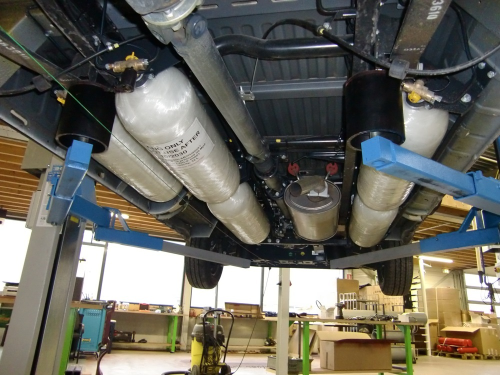
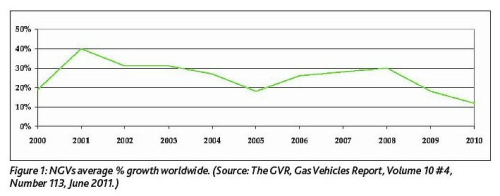
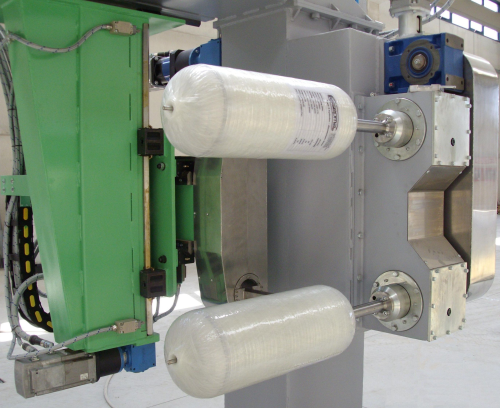
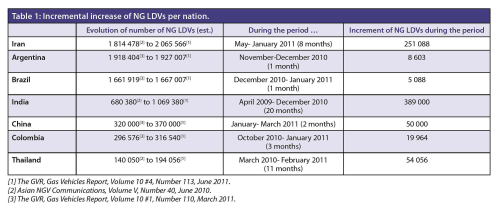
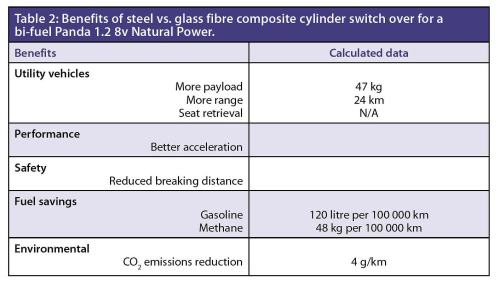
Natural gas powered vehicles (NGVs) have risen strongly in popularity over the last few years and at least 1.5 million additional vehicles hit the road every year, benefiting from the lower price of gas and its environmentally greener footprint when compared to traditional fossil fuels.
Over the last few decades the primary focus for gas powered transport was heavy duty vehicles (HDVs) – trucks and buses. However, the composites industry today has the means to target the biggest sector – passenger cars and light commercial vans or light duty vehicles (LDVs) – due to the development of new mass production technologies and capabilities that allow the manufacturing of affordable, lightweight compressed natural gas (CNG) cylinders from glass fibre composite.
Although 90% of the cylinders utilised in the NGV market at present are manufactured from steel, the challenge is not impossible to overcome considering the benefits these newly developed glass fibre composite cylinders offer to original equipment manufacturers (OEMs), converters and end-users.
The natural gas LDV market
Statistics1 show that almost 13.2 million vehicles running on natural gas were on the roads at the end of 2010 as a result of strong double digit growth over the previous decade. Even during 2010, a year after the automotive market crisis, growth reached a respectable 12% (Figure 1), albeit the lowest average annual increase worldwide during the last ten years.
If during 2010 almost 1.5 million natural gas powered vehicles came onto the roads, it is rational to consider this number as a yearly minimum for the years ahead, bearing in mind the constant lobbying of international and national associations that heavily promote increased use of on-board CNG fuel systems.
During the last 20 years the composites industry has focused primarily on the HDV segment. CNG powered vehicles need greater fuel storage space than traditional fossil fuelled vehicles and so there is a need to overcome vehicle design constraints and address the necessity to increase the payload as well.
This can be easily seen, for instance, in Europe, where many natural gas fuelled city buses are roof equipped with very low weight cylinders of more than 150 litre capacity made using carbon fibre composite thus ensuring maximum passenger payload. However, lower weight glass fibre composites are a viable financial compromise when compared to the more expensive carbon fibre solution. The use of steel is prohibitive as this is much heavier, reducing passenger payload and often requires costly, structural improvement solutions, especially to address vehicle stability. The truck and bus (HDV) segment represents about 20% of the total number of natural gas vehicles globally1 and is mainly driven – in a B2B mode – by fleet owners and OEMs, both well experienced in identifying the value of weight reduction and in determining return on their investment.
The remaining 80% of the total market concerns passenger cars and light commercial vehicles (LDVs). Data supplied by the Natural Gas Vehicle Association Europe (Table 1) estimates the incremental number – over various periods of time – of natural gas LDVs of seven different countries from the top ten NGV nations (Table 1). Pakistan and Italy, respectively 2.67 and 0.75 million LDVs in December 20101, are excluded due to the uncertainty of the incremental figures.
Based on figures from the seven countries listed in Table 1 a run rate calculation highlights 1 million new natural gas LDVs hit the road on a yearly basis. With as many as six cylinders installed per vehicle, and bearing in mind that more than 90% of today’s market is in the hands of manufacturers of steel cylinders, it is easy to assess the potential for the composites industry to equip LDVs with lighter weight natural gas cylinders manufactured using cost competitive glass fibre composites when compared with carbon fibre solutions.
Two supply chains to market co-exist – the B2B route (Tier 1 and OEMs) and the B2C route via converters or retrofitters and end-users. However, the latter group is less well informed concerning recently developed alternative solutions.
Accessibility to the LDV market
Innovations to meet the demand for mass production of natural gas cylinders for the LDV market already exist. In Europe over the last three years companies such as Xperion ALPHA Composites GmbH and Gastank Sweden AB have developed innovative Type IV composite cylinders (a polymer gas-tight liner with full filament wound fibre overwrap) using either E-CR or HiPer-tex™ glass fibres. (HiPer-tex™ is a trademark of 3B.) These cylinders:
- meet stringent test requirements under the ECE R110 regulation such as damage resistance, drop tests, impact penetration, fire resistance, fatigue performance and extreme environment tests such as exposure to corrosive acids ;
- are lightweight (55-60% lighter than equivalent water capacity steel cylinders); and
- are affordable when compared to fully carbon fibre composite tanks.
The investment in production lines for the manufacture of composite natural gas cylinders offers many advantages when compared to those made from steel. The filament winding process is more flexible, easily transferable and consumes far less energy when compared to the multiple processes required for the manufacturing of seamless steel cylinders.
OEMs are realising the advantages of composite cylinders and have started to switch (Volvo’s V70 is an example4), convinced of the weight reduction benefits these cylinders can provide as part of their own quest to reduce carbon dioxide (CO2) emissions of LDVs as directed by European regulations EC 443/2009 and EC 510/2011.
The value of weight reduction
From a purely technical standpoint the value that glass fibre reinforced thermoset composite cylinders provide to natural gas LDV users are many. As a result of the 55-60% lighter cylinders (when compared with steel), drivers of commercial vehicles are benefitting from an improvement in payload, better performance, enhanced safety, lower fuel consumption, savings in vehicle maintenance, as well as an overall reduction in CO2 emissions.
With regards to utility vehicles, every kilogram saved on the vehicle’s tare weight translates into an equal increase in payload and can be quite significant. Dutch company Greenes Group’s commercial vans – formerly equipped with five steel cylinders – demonstrated an increase of 100 kg of payload when fitted with composite cylinders made from HiPer-tex glass fibre (see Table 2). In some cases the new lighter weight glass composite cylinders even allows recovering the use of a passenger seat, previously prohibited due to the excessive overall load of steel cylinders.
Ultimately the decrease in weight translates into improved performance and better comfort for drivers of LDVs. Haven’t we all experienced better acceleration and easier manoeuvrability of our vehicle the less it is loaded? And similarly, haven’t we also noticed a shorter breaking distance, contributing to the enhancement of our safety?
Substituting steel cylinders for glass fibre composite cylinders makes LDVs lighter and leads to a decrease in fuel consumption (these vehicles are usually bi-fuel: petrol and natural gas). It results in a higher cruising range and cost savings in fuel purchases. Since CO2 emissions are proportional to fuel consumption the new glass composite cylinders decrease the vehicles’ impact on the environment.
In addition, one must not neglect the effects of lighter weight on LDV maintenance, resulting in reduced tyre wear and less premature abrasion of the clutch, which is heavily used during urban driving. It is not uncommon for those having initially installed steel cylinders and converted their vehicles to run on natural gas (in addition to petrol) to switch to lighter cylinders when they are disappointed with the hefty maintenance and repair costs the heavier systems impose.
|
1. The GVR, Gas Vehicles Report, Volume 10 #4, Number 113, June 2011. 2. Asian NGV Communications, Volume V, Number 40, June 2010. 3. The GVR, Gas Vehicles Report, Volume 10 #1, Number 110, March 2011. 4. Fleets & Fuels NGV Roma 2010 News, June 9th, 2010. 5. Fleets & Fuels NGV Roma 2010 News, June 8th, 2010. |
Another advantage is for converters or retrofitters. The ECE R110 certified glass fibre made cylinders can be installed in some LDVs without the need to reinforce the vehicle’s suspension system.
Table 2 illustrates some savings estimations resulting from the replacement of two 30 litre capacity steel cylinders with two equivalent Type IV glass fibre composite tanks on a bi-fuel Fiat Panda 1.2 8v Natural Power car.
Data highlighting the benefits of glass composite tanks can be easily computed for any given vehicle and used as a basis for financial analysis and comparison. The resulting output could help end-users in their decision to switch from steel to glass composite cylinders and some swap-overs have been publicly documented. For example, in 2010 1000 taxis in Singapore were converted with cylinders produced by Xperion ALPHA Composites GmbH5, and in 2011 Greenes Group undertook the conversion of passenger cars and light commercial vans with cylinders made using HiPer-tex glass fibres and manufactured by Gastank Sweden AB.
A viable alternative
Low weight glass fibre composite cylinders are now a reality and a viable alternative to steel cylinders for the natural gas LDV market. Certified R110 glass fibre composite cylinders increase the utility, performance and safety of vehicles and offer end-users fuel and maintenance cost savings, while at the same time decreasing the vehicle’s overall impact on the environment.
Equally important is the ability of the glass fibre industry to manufacture the large volumes required to meet the demand for natural gas cylinders for the burgeoning LDV market. 3B-the fibreglass company is well positioned as a leader in the glass fibre composite cylinders market, building on its expertise and portfolio of high performing E-CR and HiPer-tex fibres. ♦
This article was published in the September/October 2011 issue of Reinforced Plastics magazine. To appy to receive your copy of the magazine please complete the subscription form. (The digital edition of Reinforced Plastics magazine is distributed free of charge to readers who meet our qualifying criteria.)





